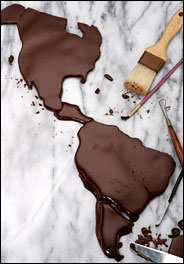
Chocolate map by Bill Yosses; photograph by Tony Cenicola/The New York Times
Ah, the sweet taste of Ghana. It reminds me of a freshly roasted cup of coffee. But I usually prefer Venezuela: it tastes deeply earthy with some acidity to give my tastebuds a kick. Sao Tome is too harsh; it makes me pucker.
Can you actually “taste” countries? Yes, if we’re talking about fine chocolate! As mentioned in my Michel Cluizel chocolate review [1], the origin of the cacao beans can greatly affect the taste of chocolate. The type of soil, humidity, sunlight and even the phases of the moon combine to make make “terroir,” the growing conditions that affect food’s taste.
The New York Times [2] even ran an article about the possibility and absurdity of identifying single-origin chocolate by country:
“We pondered the snappy break and acidic finish of chocolate from the African island of Sã Tomé and discussed how growing cacao trees in the soil of a former mango grove might result in chocolate with a faint flash of the fruit. We contemplated the raisiny ways of a bar from Papua New Guinea, which [Michel Cluizel chocolate expert Conrad] Miller suggested would go well with port. …
But when it comes down to it, can he really discern Ghana from Grenada? Ecuador from Colombia?
‘Regions I can tell. Continents, at least,’ he said. ‘I’m still working on the countries.’
If our chocolate sommelier can’t understand it all, is there hope for the rest of us?”
Taste is subjective, but a good place to start is The Nibble’s guide to regional variations in chocolate [3]. I’m not able to identify a chocolate’s origin in a blind taste test, but the guide explains why I love El Rey chocolate and like Michel Cluizel’s Los Ancones bar more than his other ones. Both of those chocolates only contain Venezuelan beans, which are known for being highly aromatic, intense and earthy. There is also a slight acidity, reminds me that I’m dealing with “dangerous” stuff.
I also noticed that Jacques Torres’ 60% house blend has notes of coffee but tastes too neutral for my liking. It’s no wonder, since he said in a chocolate demo [4] that he gets most of his beans from Ghana. The Nibble’s guide said that Ghana cacao commonly tastes like coffee and is “soothing and gentle.”
During my Michel Cluizel taste-test, I liked his Sao Tome chocolate, Tamarina, the least. Their cacao is forastero, the harshest tasting variety that Hershey’s also uses. (Hershey’s cacao comes from the Ivory Coast, a warring country that allegedly uses child labor. No wonder their chocolate tastes so bad; they have terrible terroir.) The Nibble says that Sao Tome cacao “can be tart and aggressive, full-forward on the senses, and offers little in the way of delicacy.”
Of course, there’s a caveat in choosing chocolate based only on country. Chocolate is also affected by how the beans are processed through drying, roasting and conching. Through careful handling, Michel Cluizel is able to coax the flavor out of those Sao Tome beans, so the chocolate doesn’t taste completely awful.
For more tips on how to taste chocolate, I highly recommend The Chocolate Connoisseur [5], a short but jam-packed book. Author Chloe Doutre-Roussel (who eats a pound of chocolate a day!) gives you the confidence to make tasting notes and choose a chocolate based on your mood.
</p>